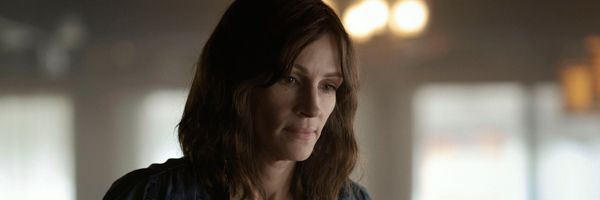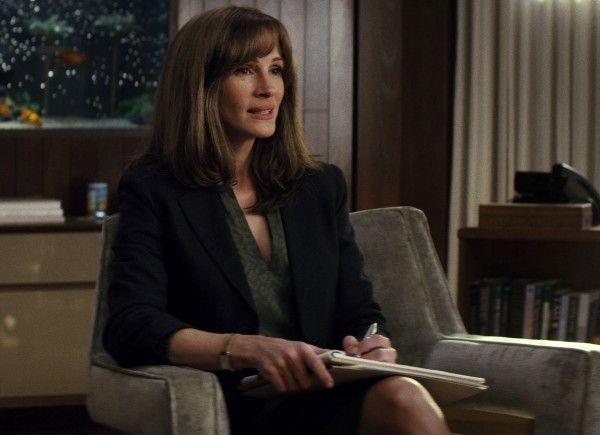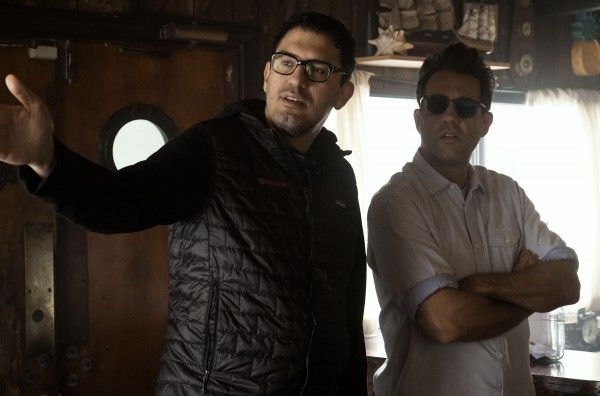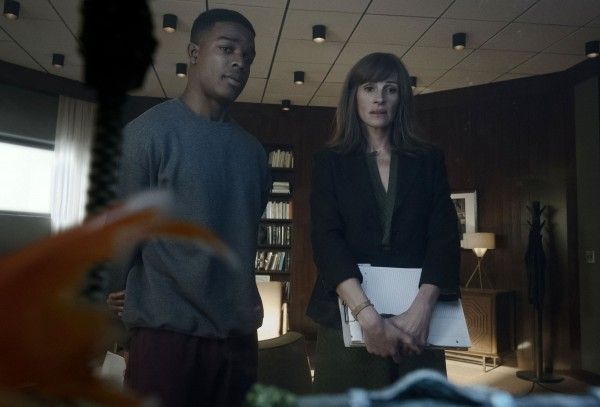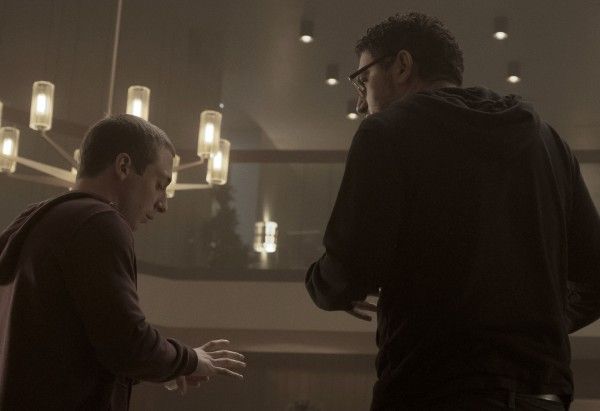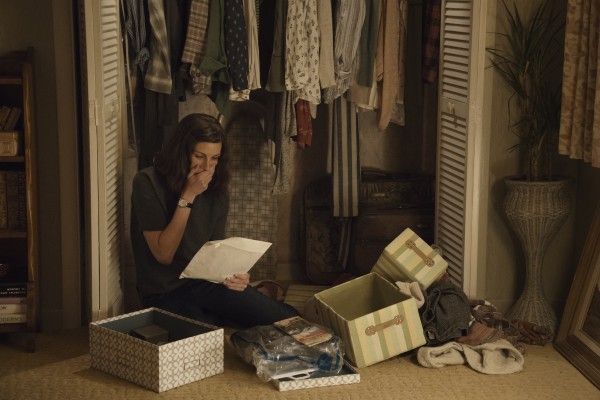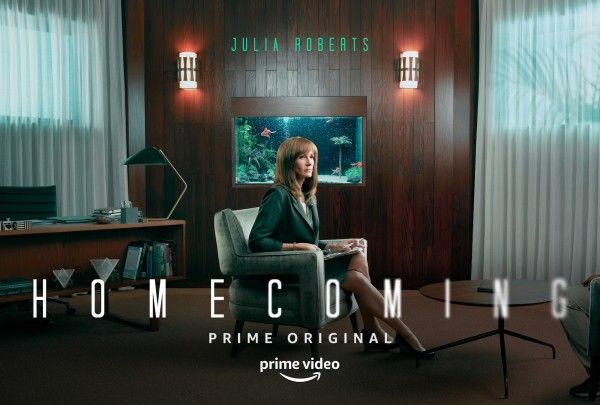From visionary director Sam Esmail (the creator of Mr. Robot) and Eli Horowitz & Micah Bloomberg, the creators of the critically acclaimed podcast of the same name, the psychological thriller Homecoming follows Heidi Bergman (Julia Roberts, in her first starring role in television), a caseworker at the Homecoming Transitional Support Center who helps soldiers deal with returning home from war. As she works with a young veteran named Walter Cruz (Stephan James) and they bond over his desire to rejoin civilian life, the two also develop a complex relationship while working through his experiences. Four years later, when a Department of Defense auditor (Shea Whigham) finds Heidi working as a waitress and living with her mother (Sissy Spacek) in a small town, his questions about her departure from her old job begin to unravel the reality that she has come to rely on.
At the Los Angeles press day for the TV series, Collider got the opportunity to chat with Sam Esmail and Julia Roberts, and they talked about being totally in sync for this collaboration, the thematic ties of the goldfish storyline, working with Sissy Spacek, the challenge of working with so many props, envisioning how to shoot the series, and finding the subtleties in the different timelines. Sam Esmail also talked about how and why he decided that Season 4 would be the last season of Mr. Robot.
Collider: I loved this! I watched all of it because I had to know how it ends.
SAM ESMAIL: Shall we ask about the ending?
JULIA ROBERTS: Okay, what did you think about the ending?
I loved the whole thing.
ESMAIL: Did you understand the ending?
ROBERTS: What was your interpretation of the ending?
I’m not sure if I fully understood any or all of it. I feel like maybe I’m not quite smart enough to fully understand what’s going on, but that doesn’t make me enjoy it any less.
ROBERTS: That’s how I feel with Sam next to me, all the time. And you know what? It’s a good feeling.
I’d rather be challenged than be 100% sure of everything that’s happening.
ROBERTS: Yeah.
ESMAIL: Cool, I’ll take that.
I’m sure it’s not awkward, at all, for you guys to talk about each other while you’re sitting together, so what was this collaboration like for you guys? Julia, what did you like about working with Sam, and Sam, what did you like about working with Julia?
ROBERTS: I know, it’s so weird. We’re getting good at it because we have stopped looking at each other. We just pretend that the other is not in the room. Honestly, there was really almost an indescribable ease that I had with Sam, within seconds of talking to him. I think that served me, as an actor, on this endeavor, in ways that I could have never anticipated because he’s very smart. I make all the jokes about how smart he is and how not smart I am, just to make the joke funnier. I’m pretty smart, but he’s exceptionally smart. And you realize, at a certain point, that there’s something about the way his brain works and the way my brain works that are very different, but completely in sync. It’s bizarre.
ESMAIL: Yeah, I would echo all of that, but I would also add to that we both are pretty passionate about this.
ROBERTS: Passionate and happy.
ESMAIL: Yes, and we have a good time.
ROBERTS: Yeah. We love our jobs. It’s so nice to have a spirited partner. Sometimes people think work has to be super hard and it has to be this intense thing, and some days were more challenging than others, but there was never a day when we were defeated or down.
ESMAIL: Wow, we’re getting philosophical here.
I love how there are all of these heavy subjects, of corporate greed and distrust of the government and how things are not done to assist soldiers when they return, and yet there’s still a storyline about the goldfish in Heidi’s office, which is amazing. How exactly did that happen?
ROBERTS: I love the goldfish, too.
ESMAIL: I love the goldfish. It’s the image we open on, and it was intentional because that’s a little bit thematically tied to what these soldiers were like. They were in a fishbowl, being examined without them being aware of it. Then, you pull back even further, as you go along in the story, and you realize that Heidi is in that fishbowl with them. She’s actually realizing that she wasn’t aware of everything that was going on. That’s the conceit of the whole show. You start with one very specific picture, and as you pull back, you re-evaluate the context, the more and more you learn about what’s happening outside.
I also love how earnest Heidi is when she says, “I don’t understand why they’re all dead. I feed them three times a day.” That’s one of my favorite scenes.
ESMAIL: She improvised in that.
ROBERTS: Everything was important to us all. As an actor, it’s delicious when you’re allowed to explore that and somebody gives you the time to make everything important.
Julia, you’ve obviously been in this business a long time and you know what the craft is. When you find something like this that challenges you, in what sounds like every way, is that surprising to find?
ROBERTS: Finding the challenges isn’t surprising. Finding the challenges alongside the support and encouragement and inspiration Sam provided me, that’s the alchemy.
There are so many great moments between you and Sissy Spacek. There’s just something so special about that relationship, even though we don’t really know much of their history. What were those moments like to explore?
ROBERTS: Just dreamy. It’s a good thing that our relationship in the show is a little contentious because otherwise I just would have been lost in her.
ESMAIL: Yeah, they loved each other.
ROBERTS: I was glad that, in the first scene, we were not even looking at each other. Our first day of shooting, we were on the sofa, watching the TV and eating our dinner, as it were. She would just say things, or she would do things with her french fry, and I would tell myself, “Don’t look at her. Just don’t even look at her. Just stay the course with what you’re supposed to be doing.” She’s so great, and she makes everybody really comfortable and happy. We had a couple of days where all of us were pinching ourselves, and we caught our breath and we found our stride with her. But, she was so game. With the magnifying glass with her cigarette, and that whole thing, I just thought, “Gosh, she is so up for doing anything.”
There’s so much dialogue in this, and you’re also doing so many things. There’s just so much going on, all the time. Was it ever confusing, doing everything at once?
ROBERTS: It was a lot of stuff, yeah. At a certain point, Sam was just keeping a list like, “What other prop can we use today? How about roller skates?” It was great because it does do something to your brain, when you’re trying to pack a bunch of stuff that has to be packed into the same sequence, every time. Get the keys, close the drawer, push the chair in, get to the door, go out the door, make sure you’ve got the phone, put in the ear pods, lock the door, walk down the stairs. Whatever I’m saying, I have no idea, at that point.
ESMAIL: Yeah, that’s the point. What I loved about giving her so many props to work with, when you’re doing all of those things, it starts to feel very real-time. It starts to feel like you’re just watching life happen.
ROBERTS: And Sam would do these oners. Honestly, it’s when you can find your stride with your crew and your castmates, and do scenes in one take, where you walk down a hallway, walk down some stairs, walk down some more stairs, walk down another hallway, go out a door, and you’re still performing the scene. It is so unique, when all of those stars align and you can accomplish that kind of stuff. It really is highly motivating.
Sam, when you read this, did you immediately see the different ways that you wanted to approach shooting this, or did you spend a lot of time thinking about how you wanted to approach that?
ESMAIL: Typically, whenever you’re envisioning how you’re going to shoot something, you have a location or a set that you’re going to build, and it’s going to built to specifications. For example, in our show, we have an office building. Because I knew, from the beginning, that I wanted to do these overhead shots to lend to this tone of being a voyeur, watching above these people, and putting our characters under a microscope, and because I knew that I was going to ask Julia to go from her office, downstairs, and we were going to creep around and peep into all of these different offices, I really have to give credit to Anastasia [White], my production designer. I just said, “Here are all the crazy things that I’m going to do. Now, you have to build around that.” What’s great about Anastasia is not only does she do that, but then she takes it to the next level and blows my mind and elevates it to a place that I didn’t even imagine. The great thing about it is we don’t let reality get in our way. For example, Heidi’s office, which turns into those therapy session scenes, is shaped in an octagon, which doesn’t actually make any sense for the building that we are in, or the location that we shoot the exterior of, but because Anastasia rightfully doesn’t care about that, we knew that we wanted the octagonal space because it is reflective of that fishbowl environment. For us, it’s always about story and character, so we think about those little details, as much as possible. We never let anything get in the way of that.
Julia, I loved your performance in this, with the subtle duality of the character, who we’re seeing in two different time periods. How did you want to approach that? Was that something that you though a lot about?
ROBERTS: Yeah. For me, it was two characters, and Sam and I talked about it a lot. In the waitress time period, there was so much vulnerability. Heidi seems harsh, in a way that she doesn’t understand and doesn’t even really acknowledge, so I was constantly going to Sam and saying, “Okay, what does she not know? What does she know that isn’t true?” One of my favorite lines is when she’s in the bedroom unpacking that box and Sissy comes in, and I say, “I was in the hospital? Why didn’t you tell me?” It’s so sweet and sincere and broken. And then, Sissy’s like, “Tell you? You were there!” It’s this great encapsulation of this poor girl, and you’re wondering, “What is going on?” The thread starts to pull, from that point. I just love the juxtaposition of that heart-sinking feeling of somebody going, “What do you mean, what’s happening to you? It’s happening to you!” That was one of my favorite things to do.
Sam, it’s officially been announced that Season 4 will be the last season of Mr. Robot. When did you know that this next season would be the last season? Is that something you’d always had planned?
ESMAIL: I always knew what the ending of the show was, so at the end of Season 3, when we went into the writers’ room for Season 4, I said, “Well, here’s the ending. Here’s where we left off. How many actual episodes do we have? Let’s not drag this out anymore than we need to. What is the number?” And we discovered that the number was 12, so that’s what we settled on. So, we said, “We’re here at the end. Let’s wrap it up this next season.”
Homecoming is available to stream at Amazon Prime on November 2nd.

